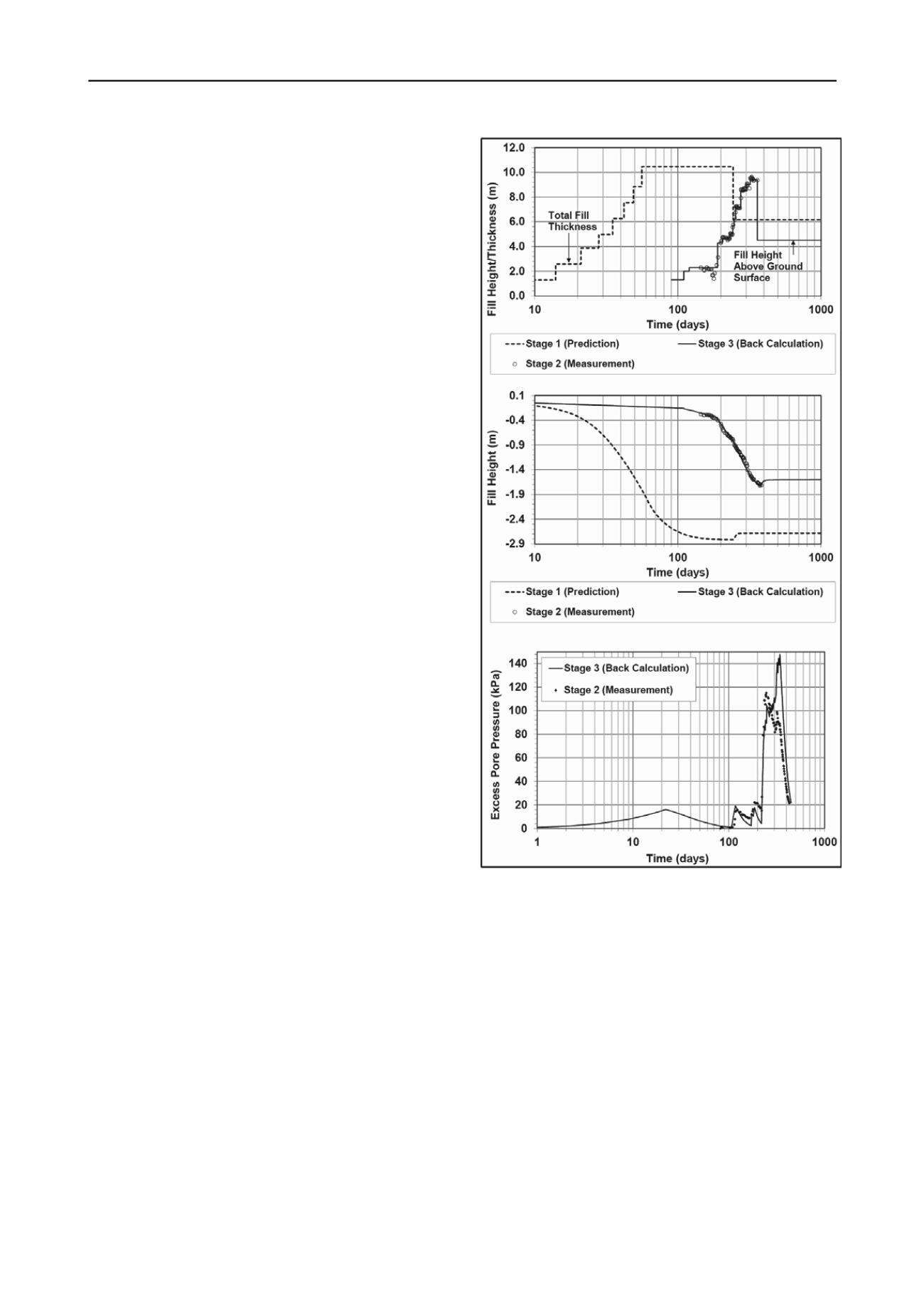
1882
Proceedings of the 18t
h
International Conference on Soil Mechanics and Geotechnical Engineering, Paris 2013
embankment construction in PLAXIS and then comparing the
primary settlement obtained from the modelling to the
settlement actually observed in the field (see Figure 4).
Calibrations were then made to the soil model to achieve an
acceptable match between observed and predicted behaviour.
The magnitude of primary settlement inferred by the Asaoka
(1978) method using a constant time step of 7 days was
compared to the actual field data and numerical predictions as
an additional validation check on the degree of consolidation
achieved. A further validation was undertaken by comparing the
actual degree of excess pore water pressure dissipation recorded
by the piezometer against the degree of excess pore water
pressure dissipation calculated by FEM during stage 3 back
analysis (see Figure 4). The magnitude of creep settlement was
estimated based on the methods described in Mesri and Feng
(1991), Mesri
et al.
(1997) and Stewart
et al.
(1994) and
compared with the design criteria. The recommended preload
duration was then refined to ensure that the predicted post
construction settlement met the design criteria.
5 RESULTS
As shown in Figure 4, the magnitude of primary settlement
predicted in Stage 1 was significantly greater than the actual
primary settlement recorded during Stage 2 field monitoring.
Compressibility and consolidation parameters were calibrated
(calibrated parameters shown bracketed in Table 1) to achieve a
good agreement between Stage 2 actual settlement results and
settlement back calculated at Stage 3. From iterations during the
Stage 3 back calculation, the source of the difference between
Stage 1 and Stage 3 settlement predictions was partly attributed
to the higher modified compression index C
cε
and modified
recompression index C
rε
adopted during Stage 1 design. As a
result, the modified secondary compression index C
αε
was also
amended. As a further validation check, the primary settlement
was also calculated using the Asaoka (1978) method. Using this
method, primary settlement of approximately 1.79m was
estimated, which compared reasonably well to the Stage 3 back
calculated primary settlement estimate (1.80m).
The degree of excess pore pressure dissipated as measured
by the piezometer during Stage 2 was compared against the
degree of excess pore water dissipation from the Stage 3 back
calculation. This comparison provided an additional validation
check in relation to the estimated degree of consolidation of the
compressible soils. A reasonable agreement between the
measured (Stage 2) and back calculated degree of excess pore
water dissipation (Stage 3) of the compressible soil was
observed (see Figure 4).
Figure 4: Predictions compared to construction monitoring
6 CONCLUSIONS
An alternative staged approach to design and construction
successfully achieved reductions of over 88,900 lineal metres of
ground improvement piling that was specified in the initial
design. BR25A approach has been presented as a ground
treatment design case study; providing key geotechnical
considerations, design methodology and a comparison of actual
embankment performance with design predictions.
Hsi J.P., Jones A.J. and Nguyen V. 2008. Ground Improvement Works
for Brunswick Heads to Yelgun Freeway,
Australian Geomechanics
Journal, March 2008.
Hird C.C., Pyrah I.C. and Russell D. 1992. Finite Element Modelling of
Vertical Drains Beneath Embankments on Soft Ground
,
Geotechnique 42(3). pp 499-511.
7 REFERENCES
Asaoka A. 1978. Observational Procedure of Settlement Prediction,
Soils and Foundations, Vol. 18, 4, pp 87-101.
Hsi J.P. and Martin J. 2005. Soft Ground Treatment and Performance,
Yelgun to Chinderah Freeway, NSW, Australia,
Ground
Improvement – Case Histories, Ed. Indraratna B. and Chu J.,
Elsevier Geo-Engineering Book Series, Volume 3, pp 563-599.
Mesri G., Stark T.D., Ajlouni M.A. and Chen C.S. 1997. Secondary
Compression of Peat with or without Surcharging,
Journal of
Geotechnical and Geo-environmental Engineering. 123(5), pp 411-
421.
Mesri G. and Feng T.W. 1991. Surcharging to Reduce Secondary
Settlement, Proceedings of International Conference on
Geotechnical Engineering for Coastal Development – Theory to
Practice,
The Japan Society of Civil Engineers, Tokyo, Japan, 3-6
September, pp 359-364.
Stewart J.P., Lacy H.S. and Ladd C.C. 1994. Settlement of Large Mat
on Deep Compressible Soil, Vertical and Horizontal Deformations
of Foundations and Embankments,
Proceedings of Settlement 94,
ASCE Geotechnical Special Publication, 40, pp 842-859.


